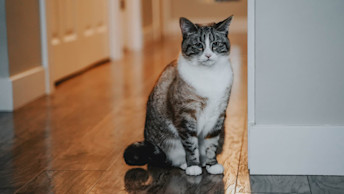July 13, 2022
What Is Diabetes in Cats and How Can You Help Manage It?

It is vital for cats and other mammals to maintain a steady level of blood sugar (glucose) as glucose plays an important role in many processes in the body.
What is diabetes?
Diabetes mellitus is a common disease in cats that results in uncontrolled blood glucose which can have detrimental effects on their liver, kidney, and heart among other concurrent issues. There’s no need to worry just yet though – keep reading to learn about what causes diabetes in cats, and how you can lower your cat’s risk for this condition.
Diabetes is all about how your pets blood sugar is regulated. In healthy cats, blood sugar levels are tightly controlled by two hormones: insulin and glucagon, which act in opposite ways to maintain normal blood sugar levels.
When blood glucose drops below normal, the pancreas secretes glucagon, which signals glucose to be released into the bloodstream, bringing blood sugar levels back up to normal. When blood glucose rises, the pancreas releases insulin, signaling certain tissues in the body to absorb glucose from the blood, therefore lowering blood glucose levels.
Diabetes occurs when the body is unable to produce enough insulin to control blood glucose levels or the cells in the body are not responsive to the insulin that is produced.
Types of diabetes
There are many types of diabetes, the most common are known as Type I diabetes and Type II diabetes. In Type I diabetes, blood glucose concentrations are high because of a lack of insulin production, most commonly due to an autoimmune disease. In Type II diabetes, can be summed up as a lack of tissue sensitivity to insulin because the body does not respond appropriately to insulin. Thus, cells become insulin resistant and as a result, do not absorb glucose from the blood as readily.
Cats are most commonly diagnosed with the Type II form of diabetes.
Carbohydrates and feline diabetes
True or False: Healthy cats can efficiently digest and absorb carbohydrates, and carbohydrate consumption has a minimal effect on blood glucose levels in cats?
TRUE!
There is a common misconception that since cats are obligate carnivores, they should not consume carbohydrates. It is also believed that the consumption of carbohydrates may increase the risk of diabetes in cats since they are broken down into sugars.
However, it has been shown that healthy cats can efficiently digest and absorb carbohydrates, and that the levels and types of dietary carbohydrates have a minimal effect on blood glucose levels in cats!1,2 Furthermore, a study found that cats fed a high carbohydrate diet compared to a low carbohydrate diet resulted in no differences in insulin levels.3 This suggests that carbohydrates do not negatively impact the insulin response or result in persistently high blood glucose levels in healthy cats.
So, if carbohydrates don’t cause feline diabetes, what does?
There are multiple factors that can increase the risk of diabetes in cats, including age, breed, and obesity. Of these factors, obesity is the most significant as overweight cats have a much greater risk of developing the disease compared to cats with an ideal body condition. The most significant risk factors of obesity include an inactive lifestyle and excessive caloric intake.4,5
Therefore, it is very important for pet parents to manage their cat’s caloric intake and body condition to help mitigate the risk of diabetes. You can use a body condition score chart for cats to be absolutely PAW-sitive that your furry friend has an ideal body condition.6
Management of diabetes in cats
If your cat does have diabetes, there are both medical and nutritional ways of managing the disease. Of the options currently available, insulin therapy has proven to be the most effective method of treatment to help control blood sugar in cats.7
As mentioned above, healthy cats can efficiently use dietary carbohydrates; however, this may not be the case for diabetic cats.8 As a result, providing lower levels of carbohydrate may be an effective method to help manage diabetes in cats by slowing the release of glucose into the bloodstream.8 Many clinical studies have found that feeding low carbohydrate diets to diabetic cats has been associated with beneficial effects, including many cats going into remission or recently diagnosed.9,10
Wet foods are often recommended due to their lower levels of carbohydrates, however, should be used with caution as they tend to be higher in fat compared to kibble and can contribute to weight gain. Our lowest carb and highest protein option is the Go! Solutions Carnivore Grain-Free Chicken, Turkey + Duck Recipe. Consult with your vet on if you are planning to make the switch to this recipe.

Recommended Solution
Protein-rich recipe for meat loving cats
This delicious grain-free, protein-rich Go! Solutions Carnivore recipe has been specially formulated to support strong, lean muscles in meat-loving cats.
View product details
Although there are documented benefits to feeding a low carbohydrate diet to diabetic cats, it is important to consider ALL macronutrients. When dietary carbohydrate levels are decreased, energy must come from fat or protein, and as such, their levels must increase.
For certain cats with additional health concerns, this can become an issue. Higher levels of fat in the diet can contribute to increased caloric intake, which can perpetuate obesity and insulin resistance.11
For aging cats, kidney disease is also a major concern. A high protein, low carbohydrate diet often includes increased phosphorus levels which are not recommended for cats with kidney failure.
Therefore, dietary management of cats with diabetes must consider all health conditions and should be discussed with your veterinarian.
Although low carbohydrate diets have proven to be beneficial for some diabetic cats, controlled blood sugar and, in some cases, remission can also be achieved by feeding higher carbohydrate diets designed to manage the disease using complex carbohydrates such as fiber.1 These specially formulated diets that include complex carbohydrates and fiber can help manage both obesity and glucose levels in cats.1
Conclusion
There are many factors that contribute to the onset of diabetes, and many ways that you can help reduce you pets risk for this disease. Most importantly, staying active, and managing their energy intake to promote an ideal body weight. Additionally, there are numerous ways to help manage diabetes in cats, clinically and nutritionally, that should be discussed with your veterinarian.
References
Verbrugghe, A. and M.J.V.s. Hesta, Cats and carbohydrates: the carnivore fantasy? 2017. 4(4): p. 55.
Asaro, N.J., et al., Carbohydrate level and source have minimal effects on feline energy and macronutrient metabolism. J. Anim. Sci., 2018: p. sky365-sky365.
Coradini, M., et al., Effects of two commercially available feline diets on glucose and insulin concentrations, insulin sensitivity and energetic efficiency of weight gain. Br. J. Nutr., 2011. 106 Suppl 1: p. S64-77.
Kienzle, E. and R. Bergler, Human-animal relationship of owners of normal and overweight cats. J. Nutr., 2006. 136(7 Suppl): p. 1947s-1950s.
Russell, K., et al., Influence of feeding regimen on body condition in the cat. J. Small Anim. Pract., 2000. 41(1): p. 12-7.
McCann, T.M., et al., Feline diabetes mellitus in the UK: the prevalence within an insured cat population and a questionnaire-based putative risk factor analysis. J. Feline. Med. Surg., 2007. 9(4): p. 289-99.
Marshall, R.D., J.S. Rand, and J.M. Morton, Treatment of newly diagnosed diabetic cats with glargine insulin improves glycaemic control and results in higher probability of remission than protamine zinc and lente insulins. J. Feline. Med. Surg., 2009. 11(8): p. 683-91.
Laflammme, D., Focus on Nutrition: Cats and carbohydrates: implications for health and disease. Compend. Contin. Educ. Vet., 2010. 32(1): p. E1-3.
Bennett, N., et al., Comparison of a low carbohydrate-low fiber diet and a moderate carbohydrate-high fiber diet in the management of feline diabetes mellitus. J. Feline. Med. Surg., 2006. 8(2): p. 73-84.
Frank, G., et al., Use of a high-protein diet in the management of feline diabetes mellitus. Vet. Ther., 2001. 2(3): p. 238-46.
Thiess, S., et al., Effects of high carbohydrate and high fat diet on plasma metabolite levels and on i.v. glucose tolerance test in intact and neutered male cats. J. Feline. Med. Surg., 2004. 6(4): p. 207-18.


